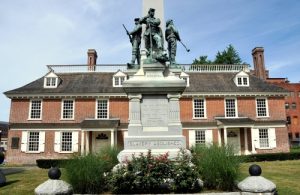Philipse Manor Hall State
Philipse Manor Hall is a grandiose estate built in the 18th century by the Dutch-born merchant Frederick Philipse. After Philipse’s death, the hall went through the hands of many families, including private owners and Yonkers city government.
After decades of serving as a municipal center and a rental facility, the hall is now a cultural monument of the past that celebrates the legacy of the Philipse family as well as a museum where where art, historic and architecture masterpieces are displayed to the public. 
What to see?
The huge estate has preserved most of its initial architecture. This provides the great opportunity for the visitors to make themselves familiar with the 18th century architecture and get back in the past when the United States was only about to take shape as a unitary country.
A representative element of those times is the papier mache Rococo ceiling that also describes the lifestyle of the original owner of the estate, Frederick Philipse. The paintings you can notice on the ceiling correspond to what Philipse loved and was interested in.
The lute players and bagpipers relate to Philipse’s love for music, while the hunting dogs represent his fondness for hunting. Other paintings you can see on the Rococo ceiling are the portraits of Pope Alexander and Isaac Newton. They hint at owner’s special interest for art and science.
The hall preserves other elements of 18th century architecture that will definitely make you want dive deeper and know more about this period.
Another place of high architectural importance on the grounds of the manor is the City Council Chamber which was the main room during the period when the hall served as municipal center. The first thing that amazes visitors’ eyes is the vaulted ceiling.
In combination with the 19th century woodwork, it provides a definition of a typical English manor hall. Aside from being a piece of art itself, the Council Chamber provides some collections of paintings.
The most prominent gallery is the one featuring American Portraiture by John Tramboll and Charles Wilson Peale. The collection contains portraits of almost all American presidents as well as six presidents of New York state. Besides that, you get the chance to know closer war heroes and historical personalities the defined the development path of the United States throughout its existence.
Science Barge
Although it wasn’t part of initial manor’s architecture, the Science Barge featuring an old design blends greatly in the general portrait of the majestic estate. Brought in 2008, the Science Barge is a scientific and educational center where lots of fresh food is produced in a zero-carbon environment, including: tomato, eggplant and lettuce.
The barge hosts educational events for school groups, where little farming enthusiasts can learn more about methods of growing crops with no harmful emissions for the environment and pesticides. They can learn the power of solar panels and biofules in heating a greenhouse and other off-grid methods that make crop growing safer and cheaper.
Old Croton Aqueduct Historic Park
In spite of being located a couple blocks away from Philipse Manor, the aqueduct is an integral part of it and has its doors open for the hall’s visitors. The Old Croton Historic Park is the preferred destination of those who are more into outdoor recreation, featuring pathways for hiking, walking and cycling.
Beczak Environmental Education Center
Another amazing destination during the Philipse Manor Hall tour is the Beczak Environmental Education Center located on the Hudson River bank and hosting educational programs where you can learn more about Hudson River’s history, biodiversity, salinity and many more.
Is it worth visiting?
If you are a fan of modern recreation facilities, visiting a 18 century manor may seem boring and time-wasting for you. However, if you are interested in old architecture and history, Philipse Manor Hall is your ultimate destination. You will get the chance to see art collections featuring historical figures as well as enjoy the elements of Rococo, Georgian and English architecture that make this manor so unique and define the lavish lifestyle of the Philipse family.
Aside from that, you can visit other facilities, like the Science Barge hosting educational programs or the Aqueduct Historic Park where you can talk a relaxing stroll with your friends or ride bike.
